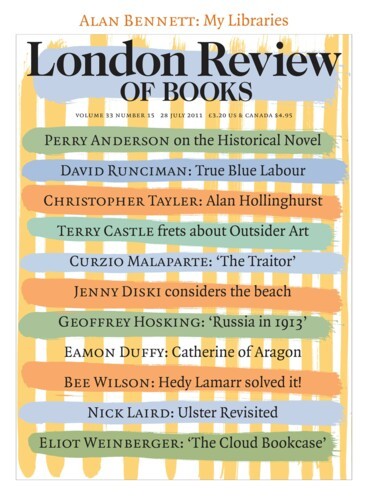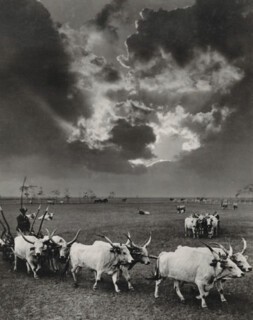Although pictures are, on the whole, reproduced in formats chosen to suit layouts, there are exceptions aimed at protecting the status of the image. Some are licensed for reproduction only if uncropped or without lettering superimposed. In serious monographs the general rule is that drawings should be reproduced the same size as the originals, or, if necessary, smaller. While there is no particular aesthetic virtue in reproducing photographic prints same size (drawings are a different matter), to do so suggests that they, too, can be considered unique works of art, not mechanical products.
Among the images in Eyewitness: Hungarian Photography in the 20th Century (at the Royal Academy until 2 October) is a photograph of a blind violinist taken by André Kertész in 1924. The print, from 1967 (Kertész made prints from his early negatives late in life), measures 25.3 cm x 20.4 cm. The full-page reproduction in the catalogue is, necessarily, slightly smaller. In André Kertész, the splendid catalogue of the 2005 exhibition of his work at the National Gallery of Art in Washington, there is a reproduction of a contact print from 1924 of the same image. It measures 5.1 cm x 3.8 cm and is reproduced to that size: a small dark rectangle in the middle of a large white page. Other contact prints from the first quarter of the 20th century are treated in the same way. In the London catalogue, on the other hand, what are captioned as ‘vintage’ contact prints are slightly enlarged and grouped. Washington gave the contact prints the respect that implies that they are unique works of art. Even though it meant reproductions so small that they are very hard to read, the effect is magisterial.
In the history of photography the status of the print has never been stable. Is it the primary aesthetic object? Or, along with the negative, transparency or digital file, is it just one stage in a reproductive process that can lead to no single predetermined outcome and gives no precedence to any one of the various versions made in various sizes for various purposes. The walls of the Royal Academy’s Sackler Wing are lined with what are, at first glance, similar artefacts: modestly sized black and white photographs. They are in a gallery so we read them as works of art. Their histories, however, are socially and aesthetically complicated, as the books and magazines displayed in cases in the gallery make clear.
A photograph from 1930 by Rudolf Balogh of a team of six oxen pulling a cart beneath a threatening sky is an art photograph, a handsome piece of nationalist pictorialism, a painterly subject printed in rich greys and blacks from more than one negative – the sky is borrowed. Such prints come fully into their own only when seen in the flesh. But Balogh had also been a war photographer, and the hanged civilian photographed in Budapest in 1919 is journalism, not art – until transformed by being hung on a gallery wall.
Five photographers are given special billing in the exhibition; they all made names for themselves outside Hungary (and changed them in the process – foreigners have difficulty with Hungarian). Any history of the medium is likely to illustrate some of the photographs by them that are on display here. For example, Brassaï’s Bijou of Montparnasse (1932), Robert Capa’s Death ofa Loyalist Militiaman (1936), Kertész’s Satiric Dancer (1926), László Moholy-Nagy’s Berlin Radio Tower (1928) all have their place in a tally of the 20th century’s most memorable images. The last of the five, Martin Munkácsi, made no single photograph that has a firm place in such lists, but The First Fashion Photograph for Harper’s Bazaar (1933) showing Lucile Brokaw running by the sea, makes clear why he was as broadly influential as any of them. He proved models could look even better on the move.
None of the five was essentially a maker of unique, collectible prints. The most successful in worldly terms were the photojournalist Capa and the magazine photographer Munkácsi. Moholy-Nagy eventually came to teach more and photograph less. Kertész, the greatest and most original of them, went to America in 1936 and lived there until his death in 1985. He spent 15 years under contract to House and Garden as a journeyman architectural photographer, working all the time on his own projects. Life turned down his picture stories; one magazine returned a pile of pictures saying: ‘We just don’t understand them.’ His work required an audience that responded to the oddity and obliqueness, sometimes to the humour, of what he discovered with his camera. These were not pictures like Capa’s, of which any editor could immediately see the significance. Brassaï, working to commission in the early 1930s, made pictures for a book about Paris by night which have more immediate impact and read faster than those in Kertész’s own book about Paris. Capa could always find work because there was always a war somewhere. Munkácsi was signed up by Harper’s Bazaar because he could make pictures, striking in themselves, that also made clothes desirable. Moholy-Nagy was a teacher who showed how a new eye could find abstract patterns in mundane reality and how that activity could be part of a designer’s education. Kertész’s work was photography for photography’s sake.
In the exhibition the pictures by less well-known cameramen who stayed at home are examples of common genres – portraits, industrial scenes, landscapes, sportsmen and women, nudes, still lifes. They are more than merely competent, but don’t match the work of the émigrés. What made Hungarian exiles figure so large in the history of 20th-century photography? The stimulus of Berlin, Paris and New York gave native talent new opportunities. Maybe the isolation and the need to establish yourself while living in a culture whose language you do not share had some part in it. It is hard to imagine their talents flourishing in postwar Hungary, had they stayed at home.
In the world of modern gallery art size matters. In Thomas Struth: Photographs 1978-2010 (at the Whitechapel Gallery until 16 September) the more recent prints are very large indeed – some almost three metres high. ‘A generation of artists,’ Armin Zweite writes in his catalogue essay, ‘take the view that their art can only be said to receive the full aesthetic recognition due to it when their extra-large picture formats have become permanent fixtures in the public arena, which is to say, in the art museum.’ Although Struth’s huge prints – artefacts only made possible by digital technology – can seem overweening, their force is not just a matter of size. The catalogue illustrations, despite being beautifully printed, prove that the scale is essential to their full effect. The smaller black and white prints from the 1970s and 1980s are of streets as empty as those in Atget’s Paris views. The prints themselves are as repetitive and technically immaculate as Bernd and Hilla Becher’s series of gable ends, winding gear and blast furnaces (Struth was a Becher student). Some of the later, larger colour photographs are literally dehumanised. Where are the workers from the office buildings that surround Dallas Parking Lot? Long views reduce the relative size of what is nearest and what furthest. Cerro Morro Solar, Lima shows a sandy expanse relieved only by the blue walls of a few of the mass of houses that fill the middle distance and by tiny specks of red where washing is hung to dry. But among exquisite images of bleakly repetitive façades pictures of great monuments begin to appear. With these come the tourists. In a mighty view of the mighty Pantheon they gather in the centre – anonymous, scale-giving manikins. Outside Notre Dame they queue, scurry and wander in ant-like, indeterminate activity. We get closer to them in photographs of church and gallery interiors: in the Vatican a blurred scrum, in the Hermitage a crowd of individuals, close-packed, solemn and attentive. We even follow them home, where families, formally arranged, seem to enjoy the group experience. All those colour pictures are large. Larger still are the Paradise series, views of forest interiors in which curtains of foliage are articulated by rising stems and branches. There is no centre of focus in Paradise 9, Xi Shuang Banna. It is like a Pollock drip painting in that it is structured but not in the traditional sense composed.
Struth’s photographs have the formality and technical perfection that large-format cameras make possible. The perspective is controlled, the framing carefully considered. He has travelled widely and much of his subject matter – Brazilian jungles, Korean tower blocks, particle accelerators – is as exotic to many of us as views of India and Japan were to 19th-century audiences when earlier large-plate photographers brought home their pictures. But the new art of the gallery photograph claims its walls not because of what it shows, but because it offers an exhibition-visiting, not a page-flipping experience. Their ponderous, thought-provoking perfection reveals the world in new terms. When Kertész, in Meudon in 1928, whether by chance or by genius, took a picture of a man carrying a wrapped parcel just at the moment when a steam engine crossed the viaduct that rose above the end of street the result was as inexplicably significant as a musical phrase. Unlike Struth’s mighty panels it is almost as wonderful as a postcard as it is as an archival print. As photography moves into the museums of modern art it loses some of the sprightliness and poetry that the Hungarians brilliantly exemplified.
Send Letters To:
The Editor
London Review of Books,
28 Little Russell Street
London, WC1A 2HN
letters@lrb.co.uk
Please include name, address, and a telephone number.


